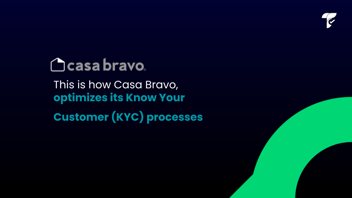In this article you will find:
Consumers are seeking financial solutions that adapt to their digitized lifestyle. In this post, I discuss banking digitization!
Convenience is the key to banking digitization. People want to lead an active financial life, and if we can say one thing about the digital world, it's that it promotes speed.
Users want speed—meaning promptness, swiftness and velocity—to access their bank accounts, transfer money, and pay bills from the comfort of their mobile devices or computers.
"Speed is the enemy of perfection," says the old adage, which is why security is also a concern. Providing fast, personalized, and quality service requires having the certainty of knowing who you are doing business with, and doing it just as quickly.
Today, I will talk about how crucial it is for banking institutions to continue innovating, updating, and adapting to the changing needs and expectations of consumers. In this post, you will see:
- How digitization is altering banking business models
- Adapting to new technological demands in the banking sector
- How digitization facilitates greater access to financial services
- The challenges of digitization
- Santander One Pay FX as an example of innovation
- Incorporating clients swiftly and ensuring security
How digitization is altering banking business models
The banking sector has had to adapt and transform its business models to meet the changing demands of consumers.
A prominent example of this transformation is Banco Santander, which has led the way in adopting innovative technologies to enhance customer experience and optimize its operations.
Artificial Intelligence: Enhancing UX
One of the key technologies that has driven Banco Santander's digital transformation is artificial intelligence (AI):
- Developing advanced data analysis systems that provide valuable insights into customer needs and preferences, allowing for more personalized services.
- Analyzing customer behavior and offering personalized recommendations on financial products of interest, increasing cross-selling opportunities.
Virtual Assistants: Improving Operational Efficiency
Another key technology adopted by Banco Santander is virtual assistants that use artificial intelligence and natural language processing to:
- Interact with customers
- Respond quickly and efficiently to their inquiries
- Assist them with tasks such as balance inquiries, money transfers, and bill payments.
As consumers, we can expect to see more exciting advancements in the future as financial institutions continue to innovate and adapt to an increasingly digitized world.
Adapting to New Technological Demands in the Banking Sector
It is essential to examine changes in employment and the skills required to adapt to new technological demands.
Transformation of Employment in the Banking Sector
Some traditional roles have evolved or disappeared, while others have emerged in response to new technological demands.
For example, ATMs and online banking systems have reduced the need for personnel in physical branches, leading to a decrease in roles such as in-person customer service and manual transaction processing.
At the same time, as banks seek to leverage technology to the fullest extent, new employment opportunities have arisen in areas such as:
- Data management;
- Cybersecurity;
- Software developmenta gestión de datos.
Skills Required in the Digitized Banking Sector
While traditional skills such as financial knowledge and customer service remain important, technological and data analysis skills are now also highly valued, including:
- The ability to work with software and digital platforms, essential in roles such as mobile app development,
- Information system management and the implementation of artificial intelligence solutions.
- Analytical skills and the ability to interpret large volumes of data are increasingly in demand in areas such as risk analysis, fraud detection and personalized customer services.
Importance of Adapting to New Technological Demands
Financial institutions also have a responsibility to train and retrain their staff to adapt to technological changes and develop the necessary skills to succeed in the digital environment and make the most of the opportunities offered by technology.
Adapting to new technological demands is crucial to ensuring the continued relevance and success of the banking sector in the digital age.
How Digitization Facilitates Greater Access to Financial Services
One of the primary ways digitization has improved access to financial services is by eliminating the physical and temporal restrictions associated with traditional bank branches.
Now, a wide range of banking transactions can be conducted from the comfort of home or on the go, through mobile devices or computers, without delays or time wasted on commuting.
Expanding the Reach of Financial Inclusion
Digitization has also allowed financial institutions to reach segments of the population traditionally underserved by conventional banking services.
Thanks to the accessibility and convenience of online services, unbanked or underbanked individuals can now open accounts, transfer money, pay bills and access a variety of other financial services without the need to visit a physical branch.
Openbank: An Example of Innovation in Digital Financial Services
A prominent example of how digitization is improving financial inclusion is Openbank, an online bank that operates exclusively through digital channels and offers a wide range of financial services, including:
- Checking accounts;
- Savings accounts;
- Credit cards;
- Loans and insurance.
To offer this service, they had to implement advanced security measures to protect financial information and ensure secure online transactions.
The Challenges of Digitization
As the banking sector enters an era of accelerated digitization, a series of challenges arise, including:
- Cybersecurity;
- Data privacy;
- The need for robust regulations to protect consumers and safeguard the integrity of the financial system.
In this section, we will explore these challenges using Banco Santander as an example and examine how they handle data management.
Cybersecurity: Protecting Digital Assets
With the increasing threat of cyberattacks, such as phishing, malware and data breaches, Banco Santander invested in advanced cybersecurity technologies to protect its digital infrastructure, including:
- State-of-the-art firewalls;
- Intrusion detection systems;
- Security awareness training programs for employeesirewalls de última generación.
Additionally, the bank conducts regular security audits and collaborates closely with cybersecurity agencies to identify and mitigate potential threats.
Data Privacy: Ensuring Client Information Confidentiality
Data privacy is another critical aspect; banks handle vast amounts of information and protecting it from unauthorized access and misuse is essential to maintaining customer trust and complying with data privacy regulations.
Banco Santander follows strict protocols that include:
- Data encryption in transit and at rest;
- Implementation of granular access controls;
- Compliance with regulations such as the General Data Protection Regulation (GDPR) in the European Union.
Additionally, the bank works closely with regulatory authorities and data protection agencies to ensure ongoing compliance with privacy regulations.
Need for Regulations: Ensuring Security and Transparency
The digitization of the banking sector demands clear standards of security and privacy, as well as transparency in business practices and data management.
Banco Santander collaborates with government regulators and participates in industry initiatives to develop and comply with rigorous compliance standards.
Additionally, they work to educate customers about their rights and responsibilities regarding data security and privacy, promoting a culture of protection throughout the organization.
Santander One Pay FX: An Example of Innovation
Santander One Pay FX is a clear example of how financial institutions are leveraging technology to enhance customer experience and simplify international financial transactions.
Santander introduced its innovative international transfer system, backed by blockchain technology, in four nations.
- Facilitates transfers to arrive at their destination on the same day on numerous occasions, or at the latest, the following day.
- In addition to the speed of transfers, the ability to show the customer the exact amount the recipient will receive in their chosen currency before the transaction is completed is highlighted.
The use of technologies like blockchain has reduced processing times and eliminated intermediaries in international transactions, resulting in lower costs and greater efficiency for customers.
Incorporate customers swiftly and ensure security
Banking digitization is irreversible and filled with opportunities and challenges.
To fully capitalize on these opportunities and onboard customers at the speed of the digital world while complying with all financial industry regulations, discover Truora Validates.
Take advantage of your free trial today and expedite the identity validation of your users to ensure they are who they claim to be, in the most efficient manner.




-4.png?width=352&name=62168a0fdc8ee75c584074c4_whatsapp%20inbound%20marketing%20(2)-4.png)